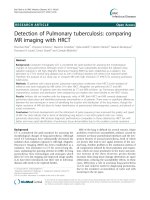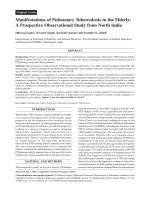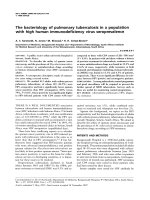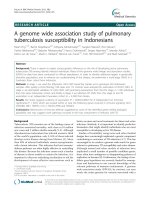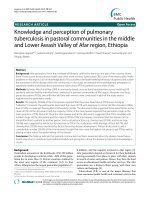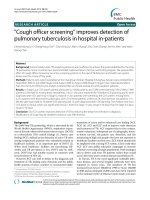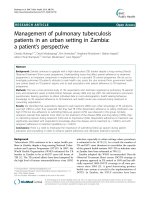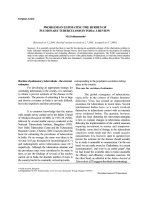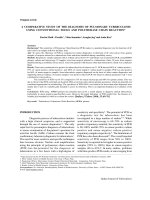ASSESSMENT OF DIAGNOSIS OF PULMONARY TUBERCULOSIS BY SPUTUM MICROSCOPY IN A DISTRICT TUBERCULOSIS PROGRAMME pdf
Bạn đang xem bản rút gọn của tài liệu. Xem và tải ngay bản đầy đủ của tài liệu tại đây (58.78 KB, 12 trang )
Ind. J. Tub., 1971, 28/1, 10-21
Ind. J. Tub., Vol. XVIII, No.
Reprinted from The Indian Journal of Tuberculosis,Vol.XVIII,No1
ASSESSMENT OF DIAGNOSIS OF PULMONARY TUBERCULOSIS BY
SPUTUM MICROSCOPY IN A DISTRICT TUBERCULOSIS PROGRAMME
K.P.RAO, S. S NAIR, N. NAGANATHAN AND R.RAJALAKSHMI
(From National Tuberculosis Institute, Bangalore)
Introduction
An infectious case of pulmonary tuberculosis
is diagnosed by demonstrating tubercle bacilli in
sputum. The laboratory methods available for this
purpose are sputum microscopy, isolation of
tubercle bacilli in culture followed by
identification of the bacilli and animal
pathogenicity tests. Evidence based on all the
three methods establishes bacteriological
diagnosis beyond any doubt, but even
economically advanced countries may not
consider such an elaborate procedure essential for
routine diagnosis. Very often sputum microscopy
alone is considered sufficient for diagnosis, when
combined with clinical findings. Therefore a
realistic and economical approach for developing
countries would be to provide only facilities for
sputum microscopy.
One of the basic principles of the Indian
District Tuberculosis Programme (DTP)
1
is to
offer diagnosis by sputum microscopy to persons
presenting at any general health institution with
complaints of symptoms such as cough for 2
weeks or more, pain in chest, fever and
haemoptysis here-in-after called ‘symptomatics’.
In the programme, non specialised staff of general
health institutions perform diagnostic and
treatment activities for tuberculosis, which are co-
ordinated and supervised by a few specialised staff
from District Tuberculosis Centre (DTC). These
non-specialised staff of general health institutions
have, therefore, to be trained in microscopy by the
staff of the DTC. In actual practice the efficiency
of diagnosis by microscopy will depend upon the
skill, aptitude, experience and conscientiousness
of the staff trained. Besides, their multiple
responsibilities, training environment and the
competence of the trainers, the distribution of
work among trained technical persons and such
other operational factors would indirectly
influence the quality of their microscopy.
To achieve and maintain a satisfactory
standard in sputum examination, routine
supervision of the general health institutions at
regular intervals constitutes no less an important
activity of the staff of DTC. At the same time,
periodical technical assessment is essential to
quantify the quality and reliability of microscopy,
organised under such conditions, and to take
timely corrective actions for improving technical
performance. Eventually, such an assessment
might help development of mathematical models
in the field of tuberculosis.
Objectives
The primary objective of the present study was
therefore to assess some aspects of the technical
quality and reliability of sputum microscopy, as
carried out in general health institutions under
conditions of DTP. It was also envisaged to utilise
the data, to formulate simpler assessment
methodologies to measure the efficiency of the
sputum diagnostic technique applied in DTP.
Material and Methods
The Bangalore district tuberculosis programme
(the programme assessed).
The Bangalore District has an area of 7798
square kilometers and had a population of about
1.3 million according to the census of 1961
(excluding the metropolitan area). The District
has 13 towns and 2477 villages. The DTP was
implemented in 1963, not by the staff of the DTC
(as happens in other districts) but by trainees of
two courses held in 1963 at the National
Tuberculosis Institute (NTI) Bangalore. In all, 15
microscopy centres were organised in general
health institutions of the District. Since, at that
time, a mobile X-ray unit was also made to visit 6
centres, these centres were excluded from the
study. Of the remaining 9 centres, 6 centres
belonged to the period of initial implementation
and 3 to the later period with programme running
for 6 months only prior to initiation of the study.
The microscopy centres were placed in different
types of health institutions, with differing staffing
pattern and functions.
Method of data collection :
Under the programme, at each microscopy
centre, a single specimen of sputum is collected
from ‘symptomatics’ and examined by Ziehl-
Neelsen (ZN) method. For the study, these smears,
along with the corresponding sputum specimens,
were collected and brought to NTI laboratory,
ASSESSMENT OF DIAGNOSIS OF PULMONARY T.B BY SPUTUM MICROSCOPY IN A DIRECT T.B. PROGRAMME
Ind. J. Tub., Vol. XVIII, No.1
11
three times a week for independent evaluation.
There, in addition to the re-examination of the
original smears, a fresh duplicate smear was
prepared from the material and examined by NZ;
microscopy at NTI was performed by an
experienced technician without knowledge of the
results of centres’ examination. Futher, sputum
specimens were cultured by swab method and all
positive cultures were further examined for growth
at room temperature, rate of growth at 37 °C,
pigment production in the dark and after exposure
to light, for catalase and peroxidase reactions,
niacin production, and drug sensitivity to
Isoniazid, Streptomycin and P-amino-salicylic
acid (PAS).
At NTI, smears were scanned for 5 minutes,
bacilli were counted and the smears were graded
as follows:
Neg
… If no bacilli were seen;
<50 …
If the actual number of
bacilli is less than 50;
+ …
If 50 or more bacilli were
recorded;
++
…
If masses of bacilli were
seen in most field ;
Positive cultures were classified as
follows :
<20 …
If actual number of
colonies was less than
twenty ;
+ …
If 20-100 colonies were
counted ;
++ …
If more than 100 colonies
were seen and
+++ …
If confluent growth was
observed.
Material was collected from the field over a
period of 18 months commencing from
September, 1963. The number of specimens
collected at each centre and the proportion of
positive among them are shown in Table 1.
From the 9 centres, 1857 specimens were
collected for further examination at NTI of these 4
specimens could not be examined by culture for
want of adequate quantity of sputum and 106 or
5.7 percent cultures were contaminated. For
another 66 specimens one smear result (either of
centre examination or of re-examination at NTI)
was not available. The analysis is therefore based
on 1681 specimens for which all the result, viz.,
centre examination, re-examination at NTI,
duplicate smear and culture were available.
TABLE 1
Number of sputum specimens collected at each centre and the proportion of positives among them.
Culture Positives Centre smear Positives
Code
No*
Centres
No of speci-
mens examined
All the four**
results available
No.
% to
Col.4
No.
% to
Col.4
1 2 3 4 5 6 7 8
1. Devanahalli 439 407 101 24.8 79 19.4
2. Doddahejjaji 278 254 21 8.3 22 8.7
3. Sulebele 199 182 23 12.6 23 12.6
4. Bidadi 193 178 22 12.4 5 2.8
5. Vijayapura 133 123 15 12.2 21 17.1
6. K.R.Pura 144 127 16 12.6 14 11.0
7. Dommasandra 131 115 15 13.0 9 7.8
8. Hesaraghatta 105 94 10 10.6 2 2.1
9. K.D.Halli 235 201 5 2.5
4 2.0
Total: 1857 1681 228 13.6 179 10.6
*These code numbers only are used hereafter (both in the text and the tables).
**(1) Direct microscopy by the centre, (2) Re-examination of the centre smears by NTI technician,
(3) Duplicate smear examination by NTI technician and (4) Culture examination of specimen.
K.P. RAO, S.S. NAIR, N. NAGANATHAN AND R. RAJALAKSHMI
Ind. J. Tub., Vol. XVIII, No.1
12
Analysis and Presentation:
As the main objective of the study was
technical assessment of sputum microscopy, these
findings have been considered first. For this
purpose culture results have been taken as
standard for comparison (Method1). Since
assessment using culture as the yard-stick can be
carried out only on a limited scale, the material
has been analysed further to provide information
on the following two simpler methods of
assessment also:
(i) Assessment based upon the results of
examination of duplicate and that of the re-
examination of the centre smears (Method
2).
(ii) Assessment based upon the result of the re-
examination of centre smears only
(Method 3).
For each assessment method, under
diagnosis* (missed cases) and over-diagnosis*
(false cases) respectively have been estimated.
The definition of a ‘case’, for such estimation
differs under each method. A case is defined as
culture positive in method1 and duplicate smear
positive in method2, and re-examination smear
positive, in method3. Under diagnosis and over-
diagnosis have also been studied fore each
individual centre. As cases were too few in some
centres, the conclusions drawn should be
considered suggestive only and illustrative of the
methodology of analysis of such assessment data.
Findings
Technical assessment based on culture results
(Method1): Under-diagnosis :
Varying proportions of culture positive cases
have been missed by the 9 centres(Table2). The
last column of this table shows that microscopist
at NTI had missed 15.8 per cent of the cases while
on the average, centre microscopists missed 38.2
percent. The proportions missed by centres 1,4,7
and 8 (particularly centres 4 and 8) were
significantly higher than 15.8 percent. Excluding
*Under-diagnosis and over-diagnosis are complements of
sensitivity and specificity respectively.
centres for 4 and 8, under-diagnosis in the other 7
centres was reduced from 38.2 to 30.6 percent.
Some idea of the reasons for under-diagnosis at
the centres could be obtained by comparing
percentages of culture positives missed by the
centres with similar percentages for re-
examinations and duplicate smear examinations.
As re-examination of the centre smears reduced
under-diagnosis from 38.2 to 29.4 per cent,
reading variations may be one factor. The reduced
percentage further dropped down to 15.8 per cent
when a duplicate smear was prepared and read by
NTI technician.
Defective smear preparation and/or intra reader
differences appear to be the other possible reason
(s). As intra-reader variation of NTI technician, in
classifying a certain proportion of smears as
positive, may not be high between re-examination
and duplicate smear examination (and is also
likely to occur in both directions) it may be
inferred that the smears prepared and stained by
the centres were somewhat inferior. In centres 4
and 8, reading error might have been a more
prominent cause than defective smear preparation
and staining. Excluding these two centres, the
percentage missed by re-examination (28.1 per
cent)was not much different from the centre
results (30.6 per cent), but under diagnosis due to
defective smear preparation and staining probably
persisted as the duplicate smear was able to reduce
the same to 14.8 per cent a statistically
significant reduction (P<0.001)
Defects in smear preparation and staining
might have occurred in centres 4,5 and 7 in which
the percentage of culture positives missed by re-
examination was considerably higher than the
percentage missed by duplicate smear
examination. But, the differences were not
significant, most probably because of the small
numbers involved. However, improvements in
smear preparation and staining are likely to further
reduce under-diagnosis in these centres.
Over-diagnosis :
Table3 shows that 2.6 per cent of the culture
negatives were declared smear positive by the
centres. Duplicate smear examination at NTI had
shown over-diagnosis of 1.2 per cent. Compared
to this, over-diagnosis was significantly higher
ASSESSMENT OF DIAGNOSIS OF PULMONARY T.B BY SPUTUM MICROSCOPY IN A DIRECT T.B. PROGRAMME
Ind. J. Tub., Vol. XVIII, No.1
13
TABLE 2
Extent of under-diagnosis by different smear examinations taking culture positives as Standard.
Cult. pos. missed by
centre’s
exam
Cult. pos. missed by
re-exam
Cult. pos. missed by
duplicate
smear examination
Centre
No.
Total cult.
Pos.
No. percent
No. Percent
No. Percent
1 2 3 4 5 6 7 8
1. 101
27 26.7
26
25.7
12
11.9
2. 21
7 33.3
8
38.1
7 33.3
3. 23
7 30.4
5
21.7
4 17.4
4. 22
19 86.4
9
40.9
5 22.7
5. 15
6 40.0
6
40.0
1 6.7
6. 16
5 31.2
4
25.0
2 12.5
7. 15
7 46.7
5
33.3
2 13.3
8. 10
8 80.0
3
30.0
2 20.0
9. 5
1 20.0
1
20.0
1 0.0
Total 228
87 38.02
67
29.4
36 15.8
TABLE 3
Extent of over-diagnosis by different smear examinations taking culture negatives as the standard
Smear positive by
Centre’s exam
Re-exam
Duplicate
smear exam
Centre Culture negatives
No. %
No. %
No. %
1 2 3 4 5 6 7 8
1. 306 5 1.6 4 1.3 7 2.3
2. 233 8 3.4 1 0.4 2 0.9
3. 159 7 4.4 7 4.4 2 1.3
4. 156 2 1.3 2 1.3 0 0.0
5. 108 12 11.1 2 1.9 1 0.9
6. 111 3 2.7 1 0.9 4 3.6
7. 100 1 1.0 1 1.0 1 1.0
8. 84 0 0.0 1 1.2 1 1.2
9. 196 0 0.0 0 0.0 0 0.0
Total 1453 38 2.6 19 1.3 18 1.2
K.P. RAO, S.S. NAIR, N. NAGANATHAN AND R. RAJALAKSHMI
Ind. J. Tub., Vol. XVIII, No.1
14
only at centre 5. Excluding this centre, this
proportion came down from 2.6 per cent to 1.9 per
cent for all the other 8 centres together.
The significantly smaller percentage of
smear positives on re-examination (1.3 per cent as
compared to 2.6 per cent) shows that reading as
differences contributed mainly to over diagnosis.
The percentage of smear positives among culture
negatives did not vary between re-examination
and duplicate smear examination by NTI
technician. Defective smear preparation and
staining, therefore, might not have influenced
over-diagnosis. The differences between re-
examination and duplicate smear examination, for
different centres, could be attributed mainly to
chance fluctuations in sampling of specimens for
smear preparation and intra-reading differences of
NTI technician.
Thus, neither under-diagnosis nor over-
diagnosis was a ‘serious problem’ in 6 out of the 9
centres. Of the remaining 3 centres, under-
diagnosis was substantial in two and over-
diagnosis in one.
Resultant over-diagnosis:
The proportion of false positives (as judged by
culture) among the total cases diagnosed as
positive by microscopy in a centre “resultant
over-diagnosis” may be of particular interest.
The resultant over-diagnosis at general health
institutions (Table not shown) was 21.2 per cent,
for re-examination of smears by NTI technician
10.6 per cent, and for duplicate smear examination
by NTI technician 8.6 per cent. The resultant over
diagnosis is influenced by both under and over-
diagnosis. For instance, centres 1 and 4 had nearly
equal over-diagnosis (1.6 percent and 1.3 per cent)
but showed 6.3 per cent and 40 per cent resultant
over-diagnosis. This way largely due to under-
diagnosis at centre 4 (86.4 per cent as compared to
26.7 per cent in center 1).
Comparison with some other tuberculosis
laboratories:
The quality of diagnosis by sputum
microscopy in general health institutions (in the
present study) was compared with that observed in
some other tuberculosis laboratories in India. Data
from some published studies of Else Holst,
Sikand, and Raj Narain were used to calculate
under and over-diagnosis based on culture. Under-
diagnosis in the general health institutions of the
present study (38.2 percent) falls in the range
observed in tuberculosis laboratories involved in
the above mentioned studies, which varied from
26 percent to 41 percent. Similarly, making an
over-diagnosis of 2.6 per cent in the general health
institutions falls in the range of 1 percent to 7.2
percent reported by these tuberculosis laboratories.
Thus, there is no reason to believe that microscopy
at all general health institutions would be inferior
to that in specialised laboratory services. On the
other hand, the wide variability observed may due
to differences in the material e.g. survey
population, clinic patients etc.,
5
and in the
techniques of microscopy and culture examination
,and emphasises that these factors may be even
more dominant.
Methods of assessment without employing
culture examination: Assessment based upon
examination of duplicate smears (Method 2) :
Under-diagnosis :
Duplicate smears prepared and examined at
NTI from 1681 specimens showed 210 positives.
Percentages of these cases missed microscopy at
the 9 centres are shown in Table 4. The extent of
under-diagnosis was 31.9 per cent for all the
centres together. Taking the duplicate smear
results of NTI as the standard, all centres (except
the last with only 4 positives) had missed fairly
high proportions of cases (i.e. significantly higher
than zero which would have been the proportion
missed if centres examination had been equally
efficient as duplicate smear examination at NTI).
Centres 4 and 8 performed poorly in this respect.
The duplicate smear positives which were missed
by the centres included 13 specimens unconfirmed
by culture. If these were excluded, under-
diagnosis by the centres would be reduced, but
this would not affect centre 4 and 8. Comprason of
the percentage missed by centre examination (31.9
per cent)with that missed by re-examination (21.9
per cent) shows that reading errors may be a cause
of unser-diagnosis, the difference being
statistically significant : 21.9 per cent missed by
re-examination itself might be partly attributed to
defects in smear preparation and staining. The
percentage of duplicate smear positives missed in
re-examination of centre smears was quite high for
centres 4,5 and 6 (significantly higher than zero).
15 K.P. RAO, S.S. NAIR, N. NAGANATHAN AND R. RAJALAKSHMI
Ind. J. Tub., Vol. XVIII, No.
Over-diagnosis:
Percentages of negative duplicate smears read
positive by centres and by re-examination,
separately, are given in Table 5. Centre 5 showed
considerable over-diagnosis and Centres 2 and 3
TABLE 4
Extent of under-diagnosis by centre’s examination and re-examination taking duplicate smear
positives as the standard
Duplicate
smear
positives
Culture
result of
missed
cases
Duplicate smear
positives
Culture result of
missed cases
Missed by
centre
Missed by re-
exam
Centre
No.
Total
No percent
Pos Neg.
No percent
Pos. Neg.
1 2 3 4 5 6 7 8 9 10
1. 96 21 21.9 15 6 19 19.8 15 4
2. 16 5 31.2 3 2 4 25.0 3 1
3. 21 4 19.0 3 1 2 9.5 1 1
4. 17 14 82.4 14 6 35.3 6
5. 15 5 33.3 5 5 33.3 5
6. 18 6 33.3 3 3 6 33.3 3 3
7. 14 5 35.7 5 3 21.4 3
8. 9 7 77.8 6 1 1 11.1 1
9. 4 0 0.0 0 0.0
Total 210 67 31.9 54 13 46 21.9 37 9
TABLE 5
Extent of over-diagnosis by centre’s examination and re-examination
taking duplicate smear negatives as the standard
Smear positive by
Centre Re- exam
Centre
No.
Duplicate
smear
negative
No
.
%
No. %
1 2 3 4 5 6
1. 311 4 1.3 2 0.6
2. 238 11 4.6 2 0.8
3. 161 6 3.7 6 3.7
4. 161 2 1.2 4 2.5
5. 108 11 10.2 1 0.9
6. 109 2 1.8 1 0.9
7. 101 0 0.0 0 0.0
8. 85 0 0.0 0 0.0
9. 197 0 0.0 0 0.0
Total 1471 36 2.4 16 1.1
K.P. RAO, S.S. NAIR, N. NAGANATHAN AND R. RAJALAKSHMI
Ind. J. Tub., Vol. XVIII, No.1
16
also showed somewhat showed considerable
over-diagnosis and Centres 2 and 3 also showed
somewhat higher than average figures, which were
statistically significant ( different from zero,
which is the expected proportion had centre-
examination been as good as duplicate smear
examination).
The proportion of such ‘false’ positives was 2.4
per cent only for centre examination, but was even
significantly less (1.1 per cent) for re-examination.
This reduction indicates that reading errors had
contributed to over-diagnosis. As only 1.1 per cent
of negative duplicate smears were considered
positive on re-examination of the centre smears by
the same NTI technician, defective smear
preparation and staining might not have
contributed much towards over-diagnosis.
Assessment based on re-examination of centre
smears (Method3):
Under-diagnosis :
Table 6 shows that 23.9 per cent of positives at
re-examination had not been considered positive
by the centres. Proportions missed were
significantly high (different from zero) for all the
centres, except 2, 7 and 9. The percentage missed
in centres 4 and 8, was significantly different from
the other centers. Excluding these two centres, the
percentage missed was reduced to 16.6. Of the
remaining centres, 5 and 6 had missed fairly high
proportions of re-examination positives (36.4 per
cent and 30.8 per cent respectively), but not
significantly higher than the remaining 5 centres.
Of the 43 positives missed by the centres, 33
only were positive on culture and represent real
under-diagnosis. But, 10 of these were negative on
culture and might be a limitation of considering
re-examination result as the standard. It is
interesting that the number of culture positives
missed was reduced from 33 to 18 by excluding
the two centres (4 and 8) showing considerable
under-diagnosis.
Over-diagnosis :
The extent to which re-examination
negatives were considered positive by the centres
is shown in Table7. It averaged 2.8 per cent for all
centres, together. However, this percentage was
much higher in centre 5 and higher than average in
TABLE 6
Extent of under-diagnosis by centre’s examination taking re-examination
smear positives as t he standard
Re- examination smear positives
Culture result of
missed cases
Missed by centre
Centre
No.
Total
No. Percent
Pos. Neg.
1 2 3 4 5 6
1 79 9 11.4 6 3
2 14 3 21.4 2 1
3 25 4 16.0 2 2
4 15 11 73.3 10 1
5 11 4 36.4 3 1
6
13 4 30.8 3 1
7
11 2 18.2 2
8
8 6 75.0 5 1
9
4
Total 180 43 23.9 33 10
ASSESSMENT OF DIAGNOSIS OF PULMONARY T.B BY SPUTUM MICROSCOPY IN A DIRECT T.B. PROGRAMME
Ind. J. Tub., Vol. XVIII, No.1
17
centres 1,2 and 6 as well; all differences being
statistically significant (different from zero).
Excluding centre 5, the proportion of ‘false’ cases
in the other centres would fall to 2.0 per cent.
TABLE 7
Extent of over-diagnosis by centre’s
examination taking re-examination negatives
as the standard
Smear positives by centre
Centre
No.
Re-exam.
Negatives
No. %
1 2 3 4
1 328 9 2.7
2 240 11 4.6
3 157 2 1.3
4 163 1 0.6
5 112 14 12.5
6 114 5 4.4
7 104 0 0.0
8 86 0 0.0
9 197 0 0.0
Total 1501 42 2.8
The above findings differ from those under
methods 1 and 2. This is due to the limitation of
considering re-examination results. For example,
out of 42 smear positives by centers among re-
examination negatives, 13 were culture positive.
Limitation of culture as standard in assessment:
Table 8 shows that 9 sputa which were
considered positive both by center examination
and re-examination, were actually negative on
culture. Of these, 4 were also positive on duplicate
smear examination i.e., positive by all the 3 types
of smear examination. Similarly, there were 5
culture negatives which were read positive by the
centers and duplicate smear examination. Further,
there was one sputum, which was considered
positive both by re-examination and duplicate
smear examination but was negative on culture
(not shown in table). Thus, in all, there were 15
sputa which were positive by at least two of the
three smear examinations but did not grow either
typical or other acid-fast bacilli on culture.
Absence of growth may be due to non-viability of
bacilli in sputum specimens. Thus, even
assessment based on culture has its limitation.
Out of the over-diagnosis reported under method 1
(2.6 per cent for centre smears and 1.2 per cent for
duplicate smears), up to 1 per cent (i.e., 15 out of
1453 negative cultures) may have to be allowed on
account of this limitation. This is on the
assumption that culture negatives which are
positive on two or more of smear examination are
TABLE 8
Correlation of culture results with results of the three types of smear
examination
Cult. Pos. Cult Neg.
Centre Smear Centre Smear
Pos. Neg.
Pos. Neg.
Re-examination Pos. 128 33 9 10
Neg. 13 54 29 1405
Total 141 87
38 1415
Pos. 138 54 5 13
Neg.
3 33 33 1402
Duplicate
smear
examination
Total 141 87
38 1415
K.P. RAO, S.S. NAIR, N. NAGANATHAN AND R. RAJALAKSHMI
Ind. J. Tub., Vol. XVIII, No.1
18
all true positives. It may be emphasized here that
the absence of growth on culture medium, which
is highly selective for tubercle bacilli, cannot rule
out presence of certain other acid-fast organisms
in specimens, which could repeatedly give
positive result on microscopy. Thus the actual
extent of error in using culture to judge over-
diagnosis by microscopy can be estimated only
after further investigations. Even if all the15 sputa
mentioned above are considered true positive, in
addition to the 228 otherwise culture positive, the
proportion of cases missed by culture works out to
6.2 per cent (15 out of 243) only and does not
influence the utility of culture as the yardstick for
judging under-diagnosis by microscopy.
Discussion
Assessment of DTP could have four major
aims :
1. To measure or evaluate achievements of
the institutions involved.
2. To indicate lines of corrective actions in
order to improve the programme.
3. To indicate further studies needed to
understand the reasons for observed
shortfalls or deviations from expectations,
and
4. To indicate improvements in methodology
of assessment itself.
In a technical assessment of the type described
in this report, the relative importance of these aims
would depend on the stage of development of the
programme. In the initial stage, as in the present
study, all the aims are likely to be equally
important. It is very essential to be assured that
the type of staff at general health institutions
entrusted with the work of sputum collection and
examination are capable of doing a technically
sound job. Once this is established, and thus the
modus operandi of integration of diagnostic
examination for tuberculosis in general health
institutions is justified, the second aim. viz., lines
of corrective actions become more important,
because both under and over-diagnosis are
undesirable for the welfare of the individuals
concerned; they affect also the assessment of
treatment efficiency and the accuracy of district
tuberculosis case index. The third and forth aims
are likely to be relatively more important in the
initial stages only.
For a proper appreciation of the present study,
it would be helpful to consider the result keeping
these four aims in view. This assessment had
demonstrated beyond doubt that non-specialised
staff of general health institutions, after being
trained by DTC staff are technically capable of
carrying out satisfactory microscopy for diagnosis
of tuberculosis. This assessment could also pick
up certain centres which were not upto the mark,
and indicate type of defects (under or over-
diagnosis) and probable reasons for the same, viz.,
reading variation or defects in preparation and
staining of smears. The part played by reading
variation in both under and over-diagnosis
emphasizes the need for a better appreciation of
the extent of such errors in examination of smears.
It is possible that defective staining may enhance
reading variation, unless the technician is
thoroughly trained and has considerable
experience. These aspects deserve to be studied
further. Possible defects in preparation and
staining of smears in some centres emphasized the
need for re-orientation of personnel concerned on
proper techniques and/or a check on quality of
chemicals used. As the study did not include a
duplicate collection of sputum by trained
technicians of the NTI, it has not been possible to
study the influence of a sputum collection on
under or over-diagnosis at different
Assessment based on
Centres with under
diagnosis
Centres with over
diagnosis
Remarks
Culture
Centres 1,4,7 and 8 Centre 5
Provides some idea of the
factors responsible for
under and over diagnosis
Duplicate smear
All centres expect
centre 9
Centres 2,3 and 5
- Do -
Re-examination of
centre smear
All centres expect
centres 2,7 and 9
Centres 1,2,5 and 6
Does not provide any idea
of the factors responsible
for under & over
diagnosis
19 K.P. RAO, S.S. NAIR, N. NAGANATHAN AND R. RAJALAKSHMI
Ind. J. Tub., Vol. XVIII, No.
centres. A further assessment could also take this
into account.
The study has also provided some insight into 3
different methods of assessment based on (1)
culture, (2) duplicate smear examination and (3)
re-examination of centre-smear. The main
conclusions can be summarised as follows:
It would be observed that duplicate smear
examination and re-examination of centre smears
led to somewhat different conclusions from the
assessment based on culture. It is, however,
reassuring that if only those centres, which show
very large discrepancies between centre smears
and re-examination or the duplicate smear results,
are considered to be below standard, then
assessment based on direct microscopy may serve
useful purpose. One serious limitation of
assessment based on re-examination is that it does
not provide any insight into the factors which may
be responsible for the defects in each centre, and
therefore, the type of corrective actions required.
However, the great advantage of re-examination
of centre-smears is its applicability on a large
scale, thereby ensuring assessment of all districts
on a regular basis. The present study has clearly
shown that in such an assessment both positive
and negative smears of each centre should be re-
examined, because both under and over-diagnosis
could occur in some centres.
It may be emphasised that errors in direct
microscopy limit to some extent, the utility of this
method alone for the purpose of assessment.
These errors may also vary according to efficiency
of the assessment technician (in preparation,
staining and reading of smears). Such
subjectiveness may not arise in assessment based
on culture which could also be extended to
provide information on drug sensitivity of strains
isolated. Further, results of culture could be used
to have a check on quality of examination by
technicians who are assigned such work, for
assessments based on duplicate smear or re-
examination of centre smears. On the other hand,
taking culture as the standard could possibly lead
to an ex-aggerated estimate of over-diagnosis (ref.
Para 2,). Even so, technical assessment based on
culture should be considered as the most reliable
method, followed by assessment based on
duplicate smear examination and then re-
examination of centre-smears.
However, from practical stand point, it may
become necessary to use all three methods. The
DTC may re-examine smears prepared and stained
by general health institutions on routine basis and
prepare and examine duplicate smears on a sample
basis. It can take immediate corrective actions
when large discrepancies are found. Institutions
with culture facilities could take up, on sample
basis, assessment based on culture to the extent
facilities permit and supplement these by
examination of duplicate smears by a well-trained
technician. As stated earlier, it would also be
necessary to have sputum collection made by well
trained technicians, so that the effect of wrong
techniques of collection can be studied. This will
have to be restricted to an even smaller sample.
Working methods could be so designed to assess
not only technical performance of general health
institutions, but also standards of district level
routine assessment.
Sputum examination standards are closely
connected with many operational factors such as
period of inservice training, types and number of
staff doing sputum examination at a centre,
efficiency of supervision, type of corrective
actions taken etc. Efficiency is likely to be
adversely affected by transfer of trained personnel
and their replacement by untrained ones,
inadequate supply of stains and other
requirements, and quality of supplies particularly
stains and slides. Some of these aspects could be
studied only subjectively in the present study.
Transfer of medical officers in three centres did
not influence quality of smear examination,
suggesting that supervision by these medical
officers was either not there (or was ineffective),
or that the standard of microscopy was so good
that there was no room for effecting further
improvement. The visit of DTC staff to these
centres was reported not to have led to technical
guidance to an extent to improve quality of
diagnosis appreciably. Therefore, the initial
training imparted to the staff for 2 to 4 weeks
appears to have been satisfactory. Supplies were
fairly regular and their quality was satisfactory
and these might not have influenced results
adversely. For a number of reasons, one of which
is the influence of the training programme of NTI,
the findings of this study should be considered
illustrative of methodology of assessment of
integrated diagnostic examination for tuberculosis.
APPENDIX TABLE
Correlation of three types of smear examinations with culturecenterwise
Re-exam. Pos. Re-exam Neg. Re-exam. Pos. Re-exam Neg.
Duplicate Duplicate Duplicate Duplicate Duplicate Duplicate Duplicate Duplicate
20
Smear Pos. Smear Neg. Smear Pos. Smear Pos. Smear Pos. Smear Neg. Smear Pos. Smear Neg.
Cult. Cult. Cult. Cult. Cult. Cult. Cult. Cult. Cult. Cult. Cult. Cult. Cult. Cult. Cult. Cult.
Centre
No.
Pos. Neg. Pos. Neg. Pos. Neg. Pos. Neg. Pos. Neg. Pos. Neg. Pos. Neg. Pos. Neg.
1 2 3 4 5 6 7 8 9 10 11 12 13 14 15 16 17
1 69 1 — — 5 — — 4 5 2 1 1 10 4 11 294
2 9 — 2 — 2 — 1 8 2 1 — — 1 1 4 223
3 16 1 — 4 — — — 2 2 — — 2 1 1 4 149
4 3 — — 1 — — — 1 8 — 2 1 6 — 3 153
5 6 1 — — 3 — — 11 3 — — 1 2 — 1 95
6 9 — — — 2 1 — 2 2 1 1 — 1 2 1 105
7 8 1 — — — — — — 2 — — — 3 — 2 99
8 2 — — — — — — — 5 1 — — 1 — 2 83
9 4 — — — — — — — — — — — — — 1 196
Ind. J. Tub., Vol. XVIII, No.1
Total 126 4 2 5 12 1 1 28 29 5 4 5 25 8 29 1397
K.P. RAO, S.S. NAIR, N.NAGANATHAN, AND R. RAJALAKSHMI
ASSESSMENT OF DIAGNOSIS OF PULMONARY T.B BY SPUTUM MICROSCOPY IN A DIRECT T.B. PROGRAMME
Ind. J. Tub., Vol. XVIII, No.1
21
The success of DTP depends largely on the
training imparted to staff of general health
services and periodic supervision followed by
corrective actions, to ensure proper standards of
work. In actual practice, the type of training
imparted and the thoroughness of supervision and
corrective actions are bound to vary from one
district to another, and this necessitates periodical
evaluation. Such an appraisal based on a simple,
purposeful, and systematic assessment
methodology, should be considered as a series of
efforts which are built into the system at
appropriate levels of the organisation and should
cover all aspects of the programme. The present
report is an illustration, though by no means
complete, for developing such a methodology.
Summary
A study was conducted in 9 such microscopy
centres in Bangalore district to find out whether
quality of diagnosis was technically sound. In
each institution a single spot specimen of sputum
had been collected from each symptomatic and
examined by Ziehl-Neelsen method. These
smears along with corresponding sputum
specimens were brought to National Tuberculosis
Institute (NTI), laboratory for re-examination of
the smears and examination of a fresh duplicate
smear by ZN and culture. In all, 1681 specimens
were analysed (for which all four results viz.,
centre examination, re-examination of centre
smear, duplicate smear and culture examination
were available). The study showed that the nine
centres had missed (under-diagnosis) 38.2 per cent
of the culture positives on direct microscopy
negatives as direct smear positives (over-
diagnosis).
Among the 9 centres, under-diagnosis was
substantial only in 2 centres and over-diagnosis in
one, indicating the need for supervision and
corrective training. Comparisons of results on re-
examination of centre smears and duplicate
smears, indicated that both reading variations and
‘defective smear preparation and staining’ could
have influenced under-diagnosis by the centres.
As culture examination can be carried out only
on a limited scale, some simpler methods of
assessment based upon duplicate smears as well as
re-examination of centre smears were also
considered. Results and limitations of these
assessments are presented. Re-examination of
centre smears is applicable on a large scale and
could ensure an assessment of all districts on a
regular basis. This method could be supplemented
by assessment based upon culture in a sample of
districts. To pick out centres which follow
defective techniques, duplicate examination could
prove quite useful, on a much larger scale than is
possible through assessment by culture. All the
three methods would be useful to develop a built-
in assessment at different levels for assessment of
case-finding by microscopy in the district
tuberculosis programme.
ACKNOWLEDGEMENT
The authors wish to thank the members of the
Technical Co-ordination Committee of the
National Tuberculosis Institute, Bangalore, in
particular Dr.D.R.Nagpaul, Director, Dr.Savic,
Senior WHO Officer and Dr.Gothi,
Epidemiologist for their helpful criticism. The
study was conducted with the active participation
of the staff of bacteriology department of the
Institute to whom we are grateful. We thank Miss
C.S.Indira Bai and Miss.T.J.Alamelu for their
sceretarial help.
REFERENCES
1. Nagpaul, D.R., (1967), ‘District Tuberculosis
Control Programme in concept and outline’, Indian
Jour. Tuberc.,14 186-198.
2. Else Holst, D.A.Mitehison and S.Radhakrishna
(1959). Examination of smears for tubercle bacilli
by Fluorescence Microscopy , Ind. Jour. Med.
Res. 47, 495-499.
3. Sikand B.K. and Ranga Rao (1958), ‘A simple pre-
treatment technique for sputum comprising the use
of a combination of Pancreatin and Cetavlon for the
routine cultivation of tubercle bacilli: Indian Jour.
Tuberc., 5 76-86.
4. Raj Narain, A.Gaser, M.V.Jambunathan and
M.Subramanyan (1963) ‘Tuberculosis prevalence
survey in Tumkur district’ Indian Jour. Tuberc., 10,
85-116.
5. Rao, K.P. Nair, S.S., Cobbold, N, and Naganathan,
N. (1966). ‘Some operational factors influencing
the utility of culture examination in the diagnosis of
pulmonary Tuberculosis’., Bull. Wld. Hith, Org.,
34,589-604

